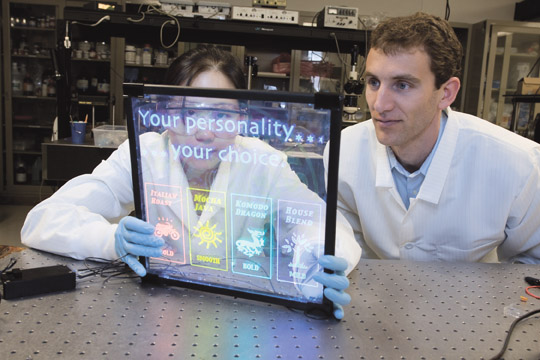University of Cincinnati College of Engineering researcher Jason Heikenfeld has started a quiet revolution in active and electronic signage. Using screen printing inks and existing light sources, Heikenfeld brings an affordable product to the sign industry with the 21st century version of the neon light—what liquid crystal display (LCD) can’t do.
University of Cincinnati College of Engineering researcher Jason Heikenfeld has started a quiet revolution in active and electronic signage. Using screen printing inks and existing light sources, Heikenfeld brings an affordable product to the sign industry with the 21st century version of the neon light—what liquid crystal display (LCD) can’t do.
Transitions Digital Graphics provides a new advertising display system to existing display manufacturers. The College of Engineering patented technology is called Light Wave Coupling, developed at UC by electrical engineering faculty members Heikenfeld and Andrew Steckl. They licensed it to a California-based company, Transitions Digital Graphics (TDG), which has trademarked it under the name of The Transitions Effect. The Transitions Effect Display System is a patented, edge-lit technology that uses invisible ink to achieve bright, multi-layer, full-color images.
“Our product will compete between traditional, single-image light boxes and active displays such as LCD or plasma screens,” says Erick Couch, TDG technology director. “Instead of one static image, three images can transition in the same advertising space for a cost close to that of a single image system.”
“It’s the only way right now, period, to start targeting active signage in a way that’s really eye catching,” says UC’s Heikenfeld. “Andrew Steckl and I started working on it together to make something almost as transparent as a window pane and put a full-color image on it…. So, for example, it’s not a Starbucks sign hanging in a window—it’s a Starbucks sign that actually morphs into a window. And you can actually partially see people on the other side, too…. If you have one layer that can go transparent to full-color image, then, of course, you can stack two or three of them and you can cycle through them.”
Advertisement
“TDG has demonstrated it to both media and industry people, who are very excited about the new technology,” says Couch. “In a nutshell, it is a novel transparent and emissive signage technology/product. This is absolutely one of the most unusual and eye-catching new options available for signage use.”
The Transitions Effect is a new, low-cost means to inject motion into advertising in place of conventional light boxes. This technology enables edge-lit displays to be printed using proprietary inks that are invisible under normal light. When subjected to ultraviolet light, these inks become visible. This allows stacking of multiple images, then selectively turning them on and off to produce eye catching effects.
• More than 85% transparency (looks like a panel of glass when turned off)
• Unlimited color gamut
• Very high brightness/self-emissive (night or sunlight viewable)
• Very high efficiency (comparable to light box)
• Thin (less than 0.25 in. thick) and stackable for morphing of multiple images
• $122/sq ft up-front materials and component cost
• Less than $1/sq ft for new content
• Compatible with existing screen or solvent inkjet printing
• Curved or flexible formats
• Small to large panels possible
“The fundamental scientific challenges have long been solved,” Couch says. “Over the last four years, Transitions has conquered the technical and business challenges of translating this technology from the laboratory into a commercial product.”
“We recognize our best role to be that of an enabler for a network of established display manufacturers, each who have their existing clientele with whom they are eager to show new technology,” Couch adds. “Our conversations with industry experts support this business model. We will authorize, train, enable and supply while developing the brand and evolving the product line.”


 Art, Ad, or Alchemy1 month ago
Art, Ad, or Alchemy1 month ago
 Case Studies1 month ago
Case Studies1 month ago
 Andy MacDougall1 month ago
Andy MacDougall1 month ago
 Columns2 weeks ago
Columns2 weeks ago
 Editor's Note2 weeks ago
Editor's Note2 weeks ago
 Thomas Trimingham2 months ago
Thomas Trimingham2 months ago
 Marshall Atkinson2 weeks ago
Marshall Atkinson2 weeks ago
 News & Trends1 month ago
News & Trends1 month ago















